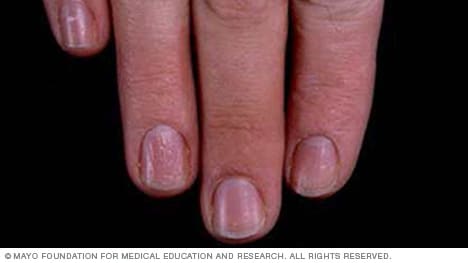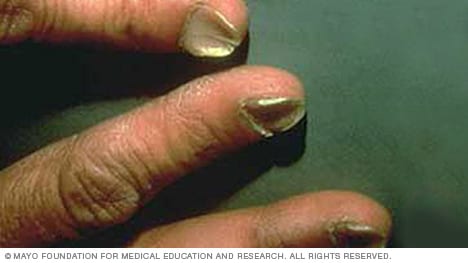7 fingernail problems not to ignore
Did you know that your fingernails can provide important information about your health? Read on to learn about how changes in the way your fingernails look could signal medical concerns that you shouldn’t ignore. If you notice these changes, make an appointment with your health care team.
Nail pitting
Nail pitting is when small round depressions or notches appear in the nails. It’s common in people who have skin disorders such as psoriasis and eczema. Nail pitting also may be related to alopecia areata — an autoimmune disease that causes hair loss.

Nail clubbing
Nail clubbing happens when the tips of the fingers get bigger and the nails curve around the fingertips. It usually develops over several years.
Nail clubbing may be caused by:
- Low oxygen in the blood.
- Lung disease.
- Heart problems.
- Liver cirrhosis.
- Gastrointestinal problems.

Spoon nails
Spoon nails are soft nails turned up around the edges. This condition also is called koilonychia.
Spoon nails often are a symptom of iron deficiency anemia. Or they may be due to a liver problem called hemochromatosis. In people who have that condition, the body absorbs too much iron from food.

Terry’s nails
In the condition called Terry’s nails, most of the fingernail looks white except for a narrow red or pink band at the top.
Terry’s nails sometimes develops because of aging. But in other cases, it may be a symptom of a serious medical condition, such as liver problems, congestive heart failure or diabetes.

Beau’s lines
Beau’s lines are grooves that run across the nails. They can appear when nail growth temporarily stops due to injury or illness.
Beau’s lines may be caused by:
- Infections.
- Diabetes that is not well controlled.
- Conditions in which narrowed blood vessels lower blood flow to the arms and legs. This is called peripheral artery disease.
- Illnesses that include a high fever, such as scarlet fever, measles, mumps and pneumonia.
- Not getting enough zinc.
- Some types of medicines, including retinoids and chemotherapy.

Nail separation
In a condition called onycholysis, the fingernails come loose and can separate from the nail bed. The separated part of the nail becomes cloudy with a white, yellow or green tint.
Sometimes detached nails are due to an injury or an infection. In other cases, nail separation is a reaction to a medicine or to a consumer product, such as nail hardeners or adhesives. Thyroid disease and psoriasis — a skin disease that causes a rash with itchy, scaly patches — also can lead to nail separation.

Yellow nail syndrome
In yellow nail syndrome, nails thicken and grow slower. This results in the nails turning a yellowish color.
Nails affected by yellow nail syndrome might lack a cuticle and detach from the nail bed in places. Yellow nail syndrome may be a symptom of a lung disease, such as chronic bronchitis. Yellow nail syndrome also can be related to swelling of the hands, arms, feet and legs — a condition called lymphedema.

June 30, 2023
See more In-depth
.
For all the latest Health News Click Here
For the latest news and updates, follow us on Google News.
